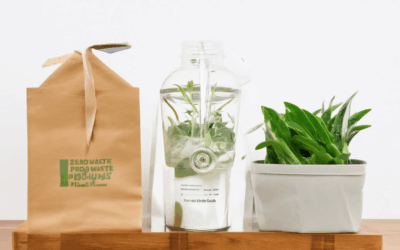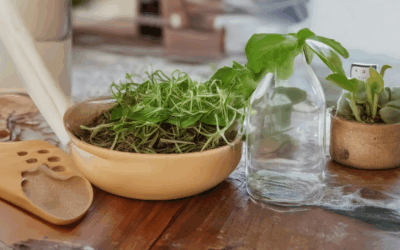Are you ready to embrace a cleaner, greener way of life? A waste-free lifestyle is not just a trend—it’s a sustainable choice that can transform how you live. By focusing on reusing, recycling, and reducing waste, you can contribute to a healthier planet while creating a more efficient household routine. Whether you’re new to the concept or looking to deepen your commitment, this guide offers practical tips, examples, and inspiration to help you adopt a zero-waste lifestyle. From understanding the core principles to exploring real-life success stories, we’ll walk you through everything you need to know to live a life that produces minimal waste. Let’s dive in and discover how you can make a meaningful impact on the world—one small change at a time.
Key Takeaways
– Adopt the 3-step approach to minimize your environmental footprint: Reduce,Reuse,Recycle.
– Focus on reducing consumption and embracing sustainable habits to cut down on waste.
– Utilize creative reuses and repurpose items to extend their lifecycle and reduce resource demands.
– Ensure proper recycling practices by understanding local guidelines and separating materials.
– Embrace the 5 R’s—Refuse, Reduce, Reuse, Repurpose, Recycle—to live a more eco-conscious life.

What is a waste-free lifestyle?
A waste-free lifestyle is a sustainable approach to living that focuses on minimizing waste generation, efficiently reusing materials, and incorporating waste into productive systems. Here’s a breakdown of key aspects:
Key Pillars of a Waste-Free Lifestyle
- Reduce: Minimize the amount of waste produced by using fewer resources and avoiding unnecessary consumption.
- Reuse: Find new purposes for items that would otherwise be discarded, extending their lifecycle and reducing landfill dependency.
- Recycle: Process materials into new products, though this should only be done after considering reuse options.
- Repurpose: Transform waste into something valuable through creative methods, such as upcycling or making DIY projects.
- Compost: Break down organic waste into nutrient-rich material that benefits the environment and gardens.
Practical Steps
- Bring reusable bags and containers to the store.
- Fix broken items rather than discarding them.
- Shop locally and in bulk to reduce packaging waste.
- Avoid single-use plastics and opt for biodegradable alternatives.
- Separate recyclables and compostables correctly to maximize efficiency.
Benefits
- Reduces environmental impact and supports sustainability goals.
- Saves resources and lowers costs associated with waste management.
- Encourages creativity and innovation through repurposing and upcycling.
- Promotes a healthier lifestyle by reducing exposure to harmful substances.
Getting Started
Start small by making simple changes in your daily routine, such as reducing plastic use, composting kitchen scraps, or participating in local recycling programs. Every effort contributes to a healthier planet for future generations.
For more tips and resources on adopting a waste-free lifestyle, visit our website .
Is it possible to live a zero waste lifestyle?
Yes, it is absolutely possible to live a zero waste lifestyle. This sustainable living approach focuses on minimizing waste generation and promoting eco-friendly habits. By making intentional choices, you can significantly reduce your environmental footprint while creating a healthier, more mindful lifestyle.
Here’s how you can get started:
1. Understand the Basics of Zero Waste
Zero waste living involves creating a system where nothing goes to landfill. It requires a combination of awareness, education, and daily actions. Key principles include reducing, reusing, recycling, and composting.
2. Reduce Waste at Home
Start by assessing your household waste and identifying areas where you can cut back. Common strategies include: – Buying in bulk to reduce packaging waste – Choosing products with minimal packaging – Reusing items instead of discarding them
3. Shop Smartly
Look for stores that offer bulk refills for essentials like grains, nuts, and cleaning supplies. Bring your own containers to fill with purchased goods, reducing plastic waste.
4. Compost Organics
Composting kitchen scraps and yard waste can turn into nutrient-rich soil, reducing landfill waste and enriching your garden. Consider getting a compost bin or worm farm.
5. Minimize Plastic Use
Reduce reliance on single-use plastics by carrying reusable items like cloth bags, water bottles, and food storage containers. Many local governments offer incentives for recycling or composting.
6. Choose Sustainable Products
Opt for products made from recycled materials or sustainably sourced ingredients. Look for certifications like Fair Trade or organic labels to ensure ethical production practices.
7. Join the Circular Economy
Participate in programs like clothing swaps, repair cafes, or book exchanges to keep items in use longer and out of landfills. Platforms like ThredUp and Patagonia Worn Wear allow you to trade or sell used items.
8. Reduce Energy and Water Use
Minimize energy consumption through efficient appliances and behaviors, such as turning off lights and fixing leaks. Conserve water by installing low-flow fixtures and being mindful of your usage.
9. Engage with Your Community
Join local zero waste groups or participate in clean-up events to connect with others who share your values. Sharing knowledge and experiences can help sustain your efforts.
By adopting these practices, you can live a fulfilling zero waste lifestyle that benefits both you and the planet. Remember, every small change adds up to make a big difference.

What Are the 5 Principles of a Zero Waste Lifestyle?
The zero waste lifestyle is built on five core principles that guide individuals toward reducing their environmental footprint while living sustainably. These principles, often referred to as the 5 Rs, form the foundation of this movement. Here’s a breakdown of each principle and how they contribute to achieving a zero waste lifestyle:
Refuse
The first step in adopting a zero waste lifestyle is to refuse unnecessary items. This means saying “no” to single-use plastics, excessive packaging, and non-essential consumer goods. By refusing, you reduce the amount of waste generated from the beginning. For example, bringing reusable containers to the store instead of accepting plastic wrap or buying in bulk to minimize packaging.
Reduce
Reduction goes hand-in-hand with refusal. It involves minimizing the quantity of resources consumed. This could mean using less water, electricity, and energy in general. Reducing also applies to the frequency of purchases—shopping less and purchasing only what is necessary helps cut down on waste.
Reuse
Reusing items extends their lifespan and reduces the need for new products. This could involve repurposing old jars, using cloth bags instead of plastic ones, or fixing broken items rather than discarding them. Reuse encourages creativity and helps in making the most out of what you already have.
Recycle
Recycling is the final step in the zero waste hierarchy. While recycling is important, it’s essential to note that not all materials can be recycled. Many items, such as food scraps, cannot be recycled and should be composted instead. Recycling should be done correctly to maximize its effectiveness and minimize contamination rates.
Rot
Rot refers to composting organic waste. Composting turns kitchen scraps, yard waste, and other biodegradable materials into nutrient-rich soil, which can be used to grow plants. This not only reduces landfill waste but also contributes to a more sustainable gardening practice.
By embracing these five principles, individuals can significantly reduce their waste production and live more harmoniously with the environment. To learn more about implementing these practices in your daily life, visit our Eco Planeta Verde homepage for guides, tips, and resources.

What are the 3 steps to living a zero waste lifestyle?
Here’s a breakdown of the three essential steps to embrace a zero-waste lifestyle:
- Reduce : Start by minimizing your consumption. Begin with small changes like using reusable containers instead of disposable ones, bringing your own bags to the store, and opting for products with minimal packaging. Reducing waste begins at home, so getting into the habit of thinking twice before purchasing is key.
- Reuse : Once you’ve reduced your waste, the next step is to reuse items as much as possible. Turn scrap paper into notepads, repurpose glass jars for storage, and find new uses for old clothing through sewing or upcycling projects. Reusing not only extends the life of products but also reduces the demand for new ones.
- Recycle : Not everything can be reused, so recycling becomes an important part of the zero-waste journey. Familiarize yourself with local recycling guidelines to ensure materials are processed correctly. While recycling is a crucial step, it’s important to remember that not all items should be recycled due to contamination risks.
By following these three steps, you can significantly reduce your environmental footprint and work towards a more sustainable lifestyle. For more tips and resources on adopting a zero-waste approach, visit our Eco Planeta Verde website.
The 5 R’s of Zero Waste Living
The 5 R’s of zero waste living are essential principles that guide individuals and communities toward reducing waste effectively. These steps not only minimize environmental impact but also foster a more sustainable and responsible lifestyle.
- Refuse : Refuse unnecessary items that contribute to waste. This includes avoiding single-use products and opting for sustainable alternatives. By refusing unnecessary packaging and excess consumption, you reduce the initial waste generated.
- Reduce : Minimize the quantity of resources used. This involves using fewer disposable items and choosing reusable options like cloth bags or water bottles. Reducing also means minimizing food waste through careful meal planning and smarter shopping.
- Reuse : Find new purposes for items you already own. Turn old jars into storage containers or repurpose cardboard boxes for organization. Reusing extends the lifespan of goods and reduces the need for new purchases.
- Repurpose : Transform waste materials into something useful. Creative repurposing ideas include making bird feeders from scrap wood or patching clothes for mending projects. This adds value to what would otherwise be discarded.
- Recycle : Properly dispose of materials that cannot be reused or repurposed. Recycling ensures that items are processed into raw materials that can be used again. However, it’s crucial to separate recyclables from compostables and hazardous waste.
By implementing these 5 R’s, individuals can play a significant role in promoting a zero-waste lifestyle, contributing to a healthier planet and a more sustainable future.

What is a Minimum Waste Lifestyle?
A minimum waste lifestyle, often referred to as a zero-waste lifestyle, is a sustainable approach focused on minimizing the amount of waste produced in daily life. This includes reducing consumption, reusing items until they no longer serve their purpose, and recycling materials that cannot be avoided. The goal is to create as little waste as possible, ideally sending nothing to landfills or incinerators.
At Eco Planeta Verde, we believe in taking small, intentional steps toward a more sustainable lifestyle. By adopting a zero-waste mindset, individuals can significantly reduce their ecological footprint while living more consciously.
Key Principles of a Zero-Waste Lifestyle
- Reduce : Minimize the purchase of disposable and unnecessary items. Prioritize durable, long-lasting products.
- Reuse : Find creative ways to repurpose items rather than discarding them. Turn scrap materials into new items.
- Recycle : Recycle materials that cannot be reduced or reused, ensuring they are processed into new products in an environmentally friendly manner.
How to Get Started
- Assess Your Household Waste : Start by understanding what types of waste you generate and look for opportunities to reduce.
- Research Local Resources : Identify local recycling centers, composting services, and repair shops that support a zero-waste lifestyle.
- Make a Commitment : Set realistic goals and track your progress over time.
Benefits of a Zero-Waste Lifestyle
- Reduces environmental pollution and strain on landfills.
- Saves money by minimizing waste and reducing consumption.
- Encourages a more mindful and intentional way of living.
Challenges to Consider
- Finding accessible and affordable options for recycling and reusing materials.
- Dealing with single-use items that are difficult to avoid.
- Developing the habit of thinking critically about consumption and waste.
Conclusion
Adopting a zero-waste lifestyle is a meaningful way to contribute to environmental sustainability. At Eco Planeta Verde, we provide practical tips and resources to help you begin your journey. Join us in making a positive impact on the planet, one small change at a time.
To learn more about sustainable living and how to adopt a zero-waste lifestyle, visit our website . We offer guides, forums, and community support to help you thrive in your new chapter.




0 Comments